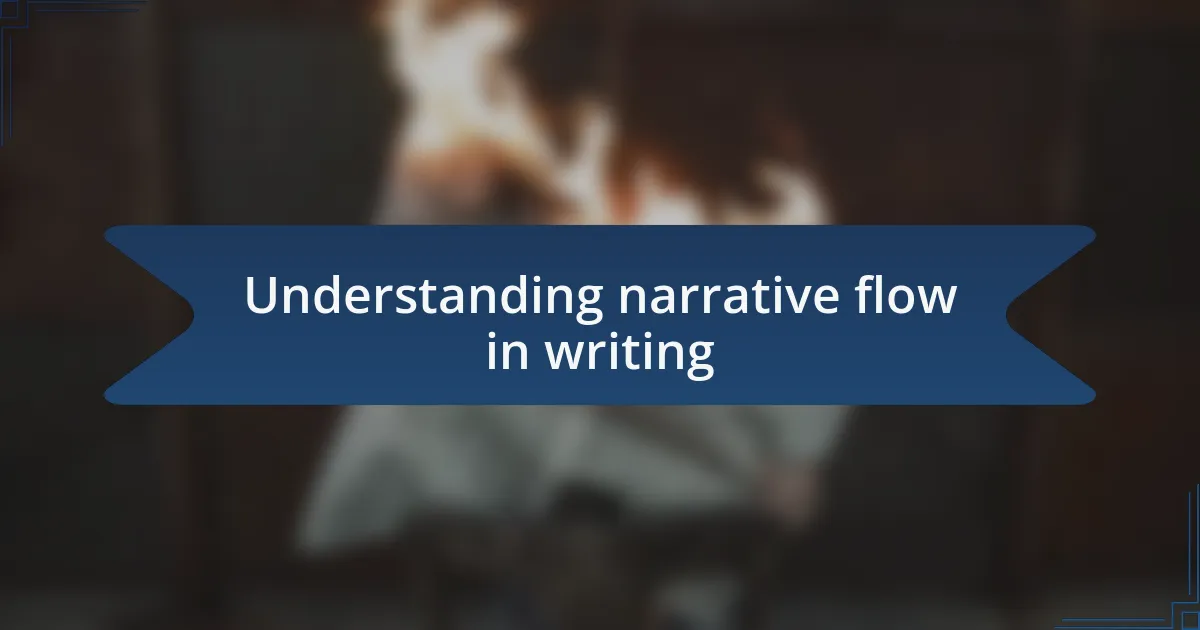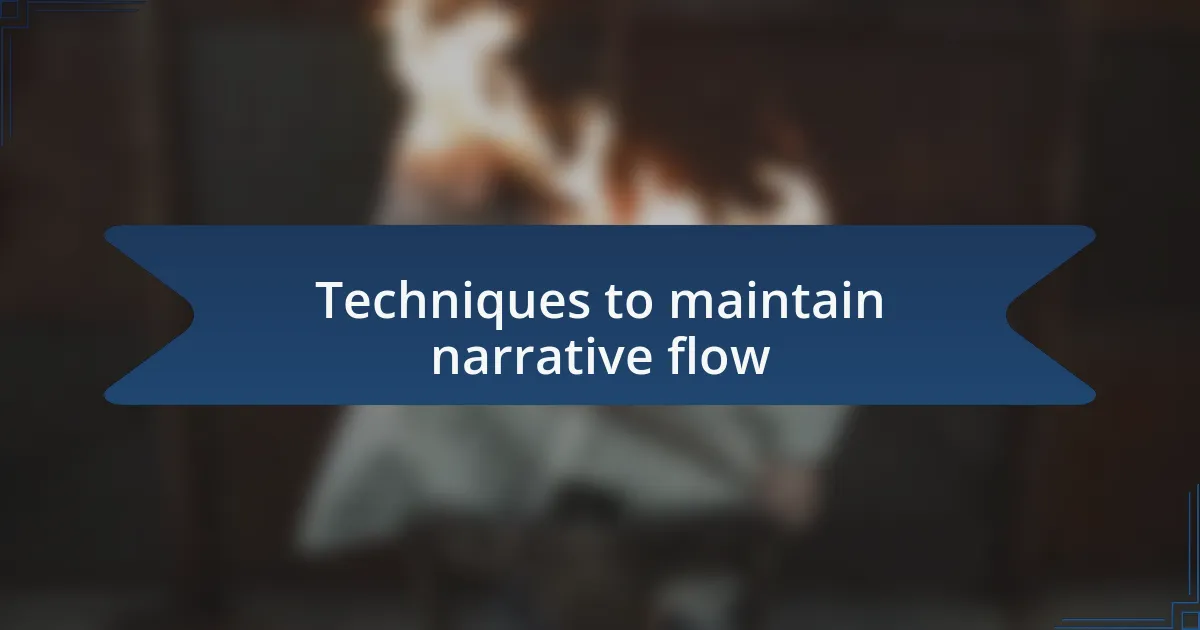Key takeaways:
- Narrative flow is essential for engaging storytelling, relying on strong connections between ideas and characters’ journeys.
- Techniques such as seamless transitions, foreshadowing, and engaging dialogue enhance narrative flow and maintain reader interest.
- Agatha Christie’s writing exemplifies effective pacing, character development, and surprising plot twists that invite deeper engagement.
- Personal strategies for maintaining flow include using cliffhangers, ensuring each scene has purpose, and varying sentence structure for dynamic reading experiences.

Understanding narrative flow in writing
Narrative flow is the backbone of effective storytelling; it’s what keeps the reader engaged from one sentence to the next. I often find that when I lose my place in writing, it’s because the connections between ideas aren’t strong enough. Have you ever experienced that moment when a story just clicks, and you can’t put it down? That’s the magic of smooth transitions and cohesive structure.
As I write, I think deeply about each character’s journey and how their actions and motivations link together. For instance, I recall a time when I struggled to depict a character’s emotional turmoil. By reframing those moments in context with the story’s events, I not only clarified their feelings but also reinforced the narrative flow. This connection is crucial—without it, even the most thrilling plot can feel disjointed.
When crafting a narrative, I often consider how pacing affects flow. Have you ever skimmed over a passage that felt too slow or too fast? Deliberately balancing action with reflection allows the reader to digest the story. I can vividly remember a suspenseful scene that felt rushed until I added pauses—moments that invited readers to hold their breath. These are the key elements that bring a narrative to life.

Techniques to maintain narrative flow
When I’m revising a piece, I focus heavily on making transitions between scenes seamless. Have you ever noticed how jarring it can be when a story suddenly jumps from one location or time to another without proper guidance? I remember feeling disoriented when reading a novel that abruptly switched locations without any indication. To avoid that in my own writing, I employ transitional phrases that signal shifts, which keeps readers grounded in the narrative.
Another technique I find invaluable is the use of foreshadowing to maintain a sense of anticipation. I can recall crafting a scene where a minor detail hinted at a future event, and the payoff later was thrilling for both me and my readers. It’s like laying down breadcrumbs; the more you leave along the way, the more compelling the journey becomes. That subtle thread weaving through different plot points creates a delightful tension, making the reader eager to find out what happens next.
I also pay attention to character dialogue to enhance narrative flow. Engaging conversations can serve not just to reveal character but also to propel the story forward. I’ve seen how a well-placed exchange between characters can clarify their intentions while seamlessly bridging gaps in the plot. Think of a conversation that moves the plot along without the reader realizing it—each word becomes part of a larger tapestry that holds their attention. It’s this interconnectedness that truly captivates and immerses the reader in the story.
Analyzing Agatha Christie’s style
Agatha Christie’s style is a masterclass in pacing and intrigue. I often marvel at how she effortlessly blends clues into her narratives, often leaving me on the edge of my seat. I’ll never forget reading “Murder on the Orient Express” for the first time. Those layers of detail she includes are like a puzzle, drawing you in while subtly guiding you toward the solution. Have you ever found yourself replaying the story in your mind, trying to untangle her threads? It’s this rhythm of revelation that keeps you engaged.
Another fascinating element of Christie’s approach is her character development. Each character feels real, with defining traits that contribute not just to the plot, but to the overall atmosphere of her stories. Just imagine sat down to tea with Miss Marple—her keen observations and wise insights bring a unique energy to the narrative. I find myself reflecting on how my own characters need this level of depth to resonate with readers. When they become more than just names on a page, that’s when the story truly comes alive.
The intriguing structure of Christie’s plots also stands out to me. She often employs a classic whodunit format, but it’s her unique twists that elevate her work. I remember racing through “And Then There Were None,” constantly second-guessing my assumptions about each character’s motivations. Has that ever happened to you? It’s exhilarating! Her ability to manipulate reader expectations not only keeps the narrative flowing but also invites deeper engagement with the text.

Personal strategies for effective flow
One strategy I find particularly effective for maintaining narrative flow is the deliberate use of cliffhangers. When I write, I often leave a chapter or section on a tantalizing note, making readers eager to turn the page. It reminds me of how I felt at the end of “The Murder of Roger Ackroyd,” unable to resist diving straight into the next chapter. Have you ever found yourself racing through a book because the suspense was just too much to handle?
Another approach is to ensure each scene has a clear purpose. I’ve learned the hard way that even minor details should serve a role in advancing the plot or deepening character development. For instance, I once crafted a scene that only showcased beautiful scenery, and I realized later it distracted from the main storyline. This taught me that every element needs to contribute, creating a seamless flow that keeps readers invested.
Finally, I constantly remind myself to vary my sentence structure. A mix of short, punchy statements and longer, descriptive passages helps to break up the monotony. I remember experimenting with this in a recent story, where I alternated between fast-paced dialogue and deeper narrative reflections. The result was exhilarating; it not only enhanced the reading experience but also mirrored the emotional highs and lows of my characters. Have you ever noticed how a shift in rhythm can alter your perception of a story?